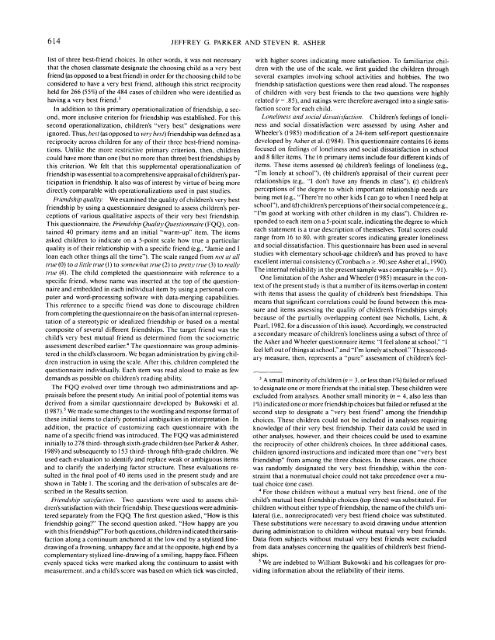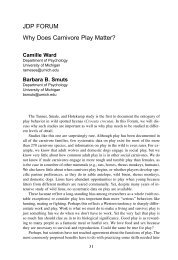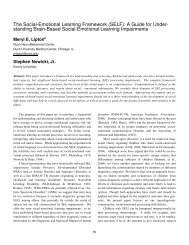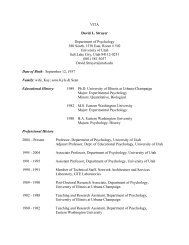Friendship and Friendship Quality in Middle Childhood ... - Psychology
Friendship and Friendship Quality in Middle Childhood ... - Psychology
Friendship and Friendship Quality in Middle Childhood ... - Psychology
Create successful ePaper yourself
Turn your PDF publications into a flip-book with our unique Google optimized e-Paper software.
614 JEFFREY G. PARKER AND STEVEN R. ASHER<br />
list of three best-friend choices. In other words, it was not necessary<br />
that the chosen classmate designate the choos<strong>in</strong>g child as a very best<br />
friend (as opposed to a best friend) <strong>in</strong> order for the choos<strong>in</strong>g child to be<br />
considered to have a very best friend, although this strict reciprocity<br />
held for 266 (55%) of the 484 cases of children who were identified as<br />
hav<strong>in</strong>g a very best friend. 3<br />
In addition to this primary operationalization of friendship, a second,<br />
more <strong>in</strong>clusive criterion for friendship was established. For this<br />
second operationalization, children's "very best" designations were<br />
ignored. Thus, best (as opposed to very best) friendship was def<strong>in</strong>ed as a<br />
reciprocity across children for any of their three best-friend nom<strong>in</strong>ations.<br />
Unlike the more restrictive primary criterion, then, children<br />
could have more than one (but no more than three) best friendships by<br />
this criterion. We felt that this supplemental operationalization of<br />
friendship was essential to a comprehensive appraisal of children's participation<br />
<strong>in</strong> friendship. It also was of <strong>in</strong>terest by virtue of be<strong>in</strong>g more<br />
directly comparable with operationalizations used <strong>in</strong> past studies.<br />
<strong>Friendship</strong> quality We exam<strong>in</strong>ed the quality of children's very best<br />
friendship by us<strong>in</strong>g a questionnaire designed to assess children's perceptions<br />
of various qualitative aspects of their very best friendship.<br />
This questionnaire, the <strong>Friendship</strong> <strong>Quality</strong> Questionnaire (FQQ). conta<strong>in</strong>ed<br />
40 primary items <strong>and</strong> an <strong>in</strong>itial "warm-up" item. The items<br />
asked children to <strong>in</strong>dicate on a 5-po<strong>in</strong>t scale how true a particular<br />
quality is of their relationship with a specific friend (e.g., "Jamie <strong>and</strong> I<br />
loan each other th<strong>in</strong>gs all the time"). The scale ranged from not at all<br />
true (0) to a little true (1) to somewhat true (2) to pretty true (3) to really<br />
true (4). The child completed the questionnaire with reference to a<br />
specific friend, whose name was <strong>in</strong>serted at the top of the questionnaire<br />
<strong>and</strong> embedded <strong>in</strong> each <strong>in</strong>dividual item by us<strong>in</strong>g a personal computer<br />
<strong>and</strong> word-process<strong>in</strong>g software with data-merg<strong>in</strong>g capabilities.<br />
This reference to a specific friend was done to discourage children<br />
from complet<strong>in</strong>g the questionnaire on the basis of an <strong>in</strong>ternal representation<br />
of a stereotypic or idealized friendship or based on a mental<br />
composite of several different friendships. The target friend was the<br />
child's very best mutual friend as determ<strong>in</strong>ed from the sociometric<br />
assessment described earlier. 4 The questionnaire was group adm<strong>in</strong>istered<br />
<strong>in</strong> the child's classroom. We began adm<strong>in</strong>istration by giv<strong>in</strong>g children<br />
<strong>in</strong>struction <strong>in</strong> us<strong>in</strong>g the scale. After this, children completed the<br />
questionnaire <strong>in</strong>dividually. Each item was read aloud to make as few<br />
dem<strong>and</strong>s as possible on children's read<strong>in</strong>g ability.<br />
The FQQ evolved over time through two adm<strong>in</strong>istrations <strong>and</strong> appraisals<br />
before the present study. An <strong>in</strong>itial pool of potential items was<br />
derived from a similar questionnaire developed by Bukowski et al.<br />
(1987). 5 We made some changes to the word<strong>in</strong>g <strong>and</strong> response format of<br />
these <strong>in</strong>itial items to clarify potential ambiguities <strong>in</strong> <strong>in</strong>terpretation. In<br />
addition, the practice of customiz<strong>in</strong>g each questionnaire with the<br />
name of a specific friend was <strong>in</strong>troduced. The FQQ was adm<strong>in</strong>istered<br />
<strong>in</strong>itially to 278 third- through sixth-grade children (see Parker &Asher,<br />
1989) <strong>and</strong> subsequently to 153 third- through fifth-grade children. We<br />
used each evaluation to identify <strong>and</strong> replace weak or ambiguous items<br />
<strong>and</strong> to clarify the underly<strong>in</strong>g factor structure. These evaluations resulted<br />
<strong>in</strong> the f<strong>in</strong>al pool of 40 items used <strong>in</strong> the present study <strong>and</strong> are<br />
shown <strong>in</strong> Table 1. The scor<strong>in</strong>g <strong>and</strong> the derivation of subscales are described<br />
<strong>in</strong> the Results section.<br />
<strong>Friendship</strong> satisfaction. Two questions were used to assess children's<br />
satisfaction with their friendship. These questions were adm<strong>in</strong>istered<br />
separately from the FQQ. The first question asked, "How is this<br />
friendship go<strong>in</strong>g?" The second question asked, "How happy are you<br />
with this friendship?" For both questions, children <strong>in</strong>dicated theirsatisfaction<br />
along a cont<strong>in</strong>uum anchored at the low end by a stylized l<strong>in</strong>edraw<strong>in</strong>g<br />
of a frown<strong>in</strong>g, unhappy face <strong>and</strong> at the opposite, high end by a<br />
complementary stylized l<strong>in</strong>e-draw<strong>in</strong>g of a smil<strong>in</strong>g, happy face. Fifteen<br />
evenly spaced ticks were marked along the cont<strong>in</strong>uum to assist with<br />
measurement, <strong>and</strong> a child's score was based on which tick was circled,<br />
with higher scores <strong>in</strong>dicat<strong>in</strong>g more satisfaction. To familiarize children<br />
with the use of the scale, we first guided the children through<br />
several examples <strong>in</strong>volv<strong>in</strong>g school activities <strong>and</strong> hobbies. The two<br />
friendship satisfaction questions were then read aloud. The responses<br />
of children with very best friends to the two questions were highly<br />
related (r = .85), <strong>and</strong> rat<strong>in</strong>gs were therefore averaged <strong>in</strong>to a s<strong>in</strong>gle satisfaction<br />
score for each child.<br />
Lonel<strong>in</strong>ess <strong>and</strong> social dissatisfaction. Children's feel<strong>in</strong>gs of lonel<strong>in</strong>ess<br />
<strong>and</strong> social dissatisfaction were assessed by us<strong>in</strong>g Asher <strong>and</strong><br />
Wheeler's (1985) modification of a 24-item self-report questionnaire<br />
developed by Asher et al. (1984). This questionnaire conta<strong>in</strong>s 16 items<br />
focused on feel<strong>in</strong>gs of lonel<strong>in</strong>ess <strong>and</strong> social dissatisfaction <strong>in</strong> school<br />
<strong>and</strong> 8 filler items. The 16 primary items <strong>in</strong>clude four different k<strong>in</strong>ds of<br />
items. These items assessed (a) children's feel<strong>in</strong>gs of lonel<strong>in</strong>ess (e.g.,<br />
"I'm lonely at school"), (b) children's appraisal of their current peer<br />
relationships (e.g., "I don't have any friends <strong>in</strong> class"), (c) children's<br />
perceptions of the degree to which important relationship needs are<br />
be<strong>in</strong>g met (e.g., "There're no other kids I can go to when I need help at<br />
school"), <strong>and</strong> (d) children's perceptions of their social competence (e.g.,<br />
"I'm good at work<strong>in</strong>g with other children <strong>in</strong> my class"). Children responded<br />
to each item on a 5-po<strong>in</strong>t scale, <strong>in</strong>dicat<strong>in</strong>g the degree to which<br />
each statement is a true description of themselves. Total scores could<br />
range from 16 to 80, with greater scores <strong>in</strong>dicat<strong>in</strong>g greater lonel<strong>in</strong>ess<br />
<strong>and</strong> social dissatisfaction. This questionnaire has been used <strong>in</strong> several<br />
studies with elementary school-age children's <strong>and</strong> has proved to have<br />
excellent <strong>in</strong>ternal consistency (Cronbach a > .90; see Asher et al., 1990).<br />
The <strong>in</strong>ternal reliability <strong>in</strong> the present sample was comparable (a = .91).<br />
One limitation of the Asher <strong>and</strong> Wheeler (1985) measure <strong>in</strong> the context<br />
of the present study is that a number of its items overlap <strong>in</strong> content<br />
with items that assess the quality of children's best friendships. This<br />
means that significant correlations could be found between this measure<br />
<strong>and</strong> items assess<strong>in</strong>g the quality of children's friendships simply<br />
because of the partially overlapp<strong>in</strong>g content (see Nicholls, Licht, &<br />
Pearl, 1982, for a discussion of this issue). Accord<strong>in</strong>gly, we constructed<br />
a secondary measure of children's lonel<strong>in</strong>ess us<strong>in</strong>g a subset of three of<br />
the Asher <strong>and</strong> Wheeler questionnaire items: "I feel alone at school," "I<br />
feel left out of th<strong>in</strong>gs at school," <strong>and</strong> "I'm lonely at school ."This secondary<br />
measure, then, represents a "pure" assessment of children's feel-<br />
3 A small m<strong>in</strong>ority of children (n = 3, or less than 1%) failed or refused<br />
to designate one or more friends at the <strong>in</strong>itial step. These children were<br />
excluded from analyses. Another small m<strong>in</strong>ority (n = 4, also less than<br />
1 %) <strong>in</strong>dicated one or more friendship choices but failed or refused at the<br />
second step to designate a "very best friend" among the friendship<br />
choices. These children could not be <strong>in</strong>cluded <strong>in</strong> analyses requir<strong>in</strong>g<br />
knowledge of their very best friendship. Their data could be used <strong>in</strong><br />
other analyses, however, <strong>and</strong> their choices could be used to exam<strong>in</strong>e<br />
the reciprocity of other children's choices. In three additional cases,<br />
children ignored <strong>in</strong>structions <strong>and</strong> <strong>in</strong>dicated more than one "very best<br />
friendship" from among the three choices. In these cases, one choice<br />
was r<strong>and</strong>omly designated the very best friendship, with<strong>in</strong> the constra<strong>in</strong>t<br />
that a nonmutual choice could not take precedence over a mutual<br />
choice (one case).<br />
4 For those children without a mutual very best friend, one of the<br />
child's mutual best friendship choices (top three) was substituted. For<br />
children without either type of friendship, the name of the child's unilateral<br />
(i.e., nonreciprocated) very best friend choice was substituted.<br />
These substitutions were necessary to avoid draw<strong>in</strong>g undue attention<br />
dur<strong>in</strong>g adm<strong>in</strong>istration to children without mutual very best friends.<br />
Data from subjects without mutual very best friends were excluded<br />
from data analyses concern<strong>in</strong>g the qualities of children's best friendships.<br />
5 We are <strong>in</strong>debted to William Bukowski <strong>and</strong> his colleagues for provid<strong>in</strong>g<br />
<strong>in</strong>formation about the reliability of their items.





